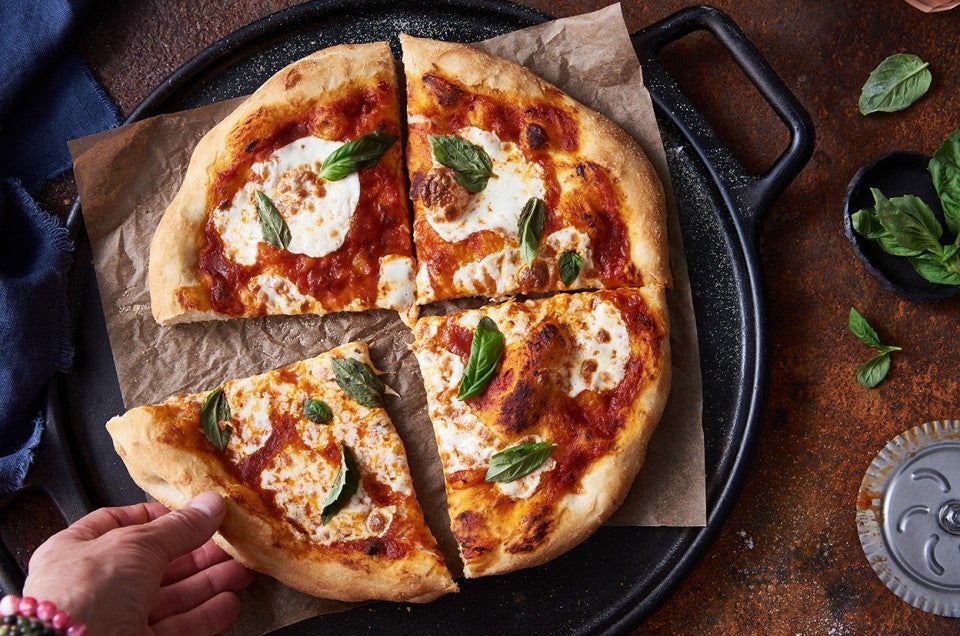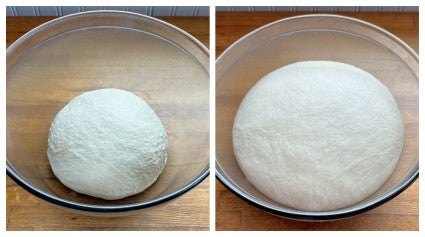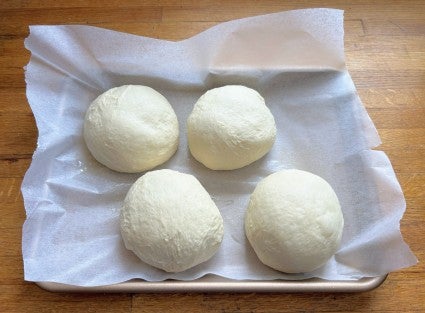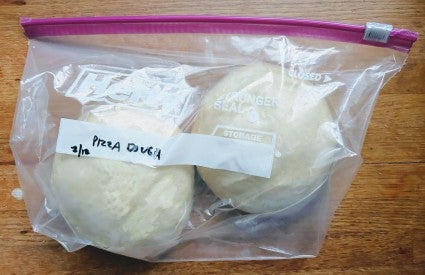


A good crust is the foundation of great homemade pizza, whether you’re making your favorite basic crust, a bubbly Neapolitan-style, a flavorful sourdough, or even a crispy gluten-free crust. But preparing pizza dough at home can be time-consuming. Maybe you’ve bought frozen pizza dough at the store, and wondered: Can I freeze my own homemade pizza dough?
Yes! Once the dough has gone through its first rise, divide, wrap, and freeze it. When the pizza craving hits, you need simply to thaw the dough and pick up where you left off: shaping a crust, letting it rise, topping, and baking.
Still, it’s not just a matter of bagging up dough and tossing it into the freezer. For the best results while freezing pizza dough, follow this process.

This may seem self-evident, but don’t try a brand-new pizza recipe when you’re planning to freeze the dough. If the freezing process fails, you won’t know if it’s the recipe itself, or how you froze the dough.
Almost any pizza dough recipe is suitable for freezing, but if your recipe doesn’t already include fat, replace 2 to 3 tablespoons of the recipe’s water with olive or vegetable oil. Doing this will help reduce the formation of ice crystals (as well as minimize their size), which can damage both yeast and gluten.
You may also choose to increase the recipe’s yeast by 50%, especially if you want to keep the dough frozen for longer than a couple of weeks. While dry yeast is basically unaffected by cold (which is why you can safely store your packaged yeast in the freezer), yeast activated with liquid is prone to damage during the freezing/thawing process. Adding more yeast than normal to the dough helps ensure enough remains when you’re ready to bake.

You want the dough’s yeast to be fully active before putting it into hibernation in the freezer. Give the dough enough time to double in size before freezing. While it’s fine to include some overnight cold fermentation (to enhance the dough’s flavor), don’t try freezing a lump of leftover dough that’s been hidden in the fridge for days.

Your recipe should indicate how many and what size crusts it’ll yield. But if you don’t like the recipe’s suggestion and want to make, say, small personalized pizzas (or a big Sicilian-style rectangle), just weigh your dough and divide it the way you want.
Shape each piece of dough into a ball or a slightly flattened round. How you shape the portioned dough depends mainly on the space available in both your freezer (storage) and refrigerator (thawing). Either way, lightly flour or oil the surface of the dough, to help prevent it from sticking to its wrapping later.
Note: Why not shape the dough into its final stretched and flattened crust shape right away, before freezing? First, because unless you’re making very small pizzas, a shaped crust is an awkward fit for most freezers and refrigerators. And second, if you’re going that far, you might as well take it one step further and pre-bake the crust, which will greatly extend its viability in the freezer. For details, see How to make homemade frozen pizza.
Arrange the shaped dough on a baking sheet or other firm surface, and place it in the coldest part of the freezer, uncovered. You want to freeze the dough as quickly as possible; for best results, your freezer temperature should be around 0°F. After about an hour (or when the dough is no longer sticky or soft), it’s ready to wrap.

Wrap the dough “skin tight” in plastic, then place in a plastic bag for additional protection. Store it in the coldest part of your freezer, preferably away from the door. The more the dough is subject to temperature changes, the greater the chance ice crystals will form. For this reason, it’s best to store pizza dough in a freezer that’s not self-defrosting. (Your best bet: a basic chest freezer.)

We suggest freezing pizza dough no longer than a month. While pizza dough is a better candidate for freezing than most yeast doughs, over time in the freezer some of the yeast will die — generally from ice damage, or simply from stress.
Serendipitously, though, dead yeast releases a substance called glutathione, which acts as a natural dough relaxer. So frozen and thawed pizza dough is actually easier to shape than fresh dough.
Unlike popping a store-bought frozen pizza into the oven and setting it on the table 15 minutes later, turning your homemade frozen pizza dough into hot pizza doesn’t happen quickly. It’s best to leave yourself 10 to 12 hours between deciding you want pizza and sitting down to enjoy it.
First, remove however much dough you want from the freezer and unwrap it. Place the rounds on a baking sheet, and tent them gently with plastic. Let them thaw in the refrigerator for six to 10 hours, until they’re soft all the way through. Flattened rounds will thaw a bit faster than balls.

Shape each piece of dough into a crust (on parchment or in a pan), cover the crusts, and let them rise at room temperature. How long this final rise takes depends on the warmth of your rising space, how strong the dough is after its time in the freezer, and, most important, how thick you want your crust to be. For a thin, crispy crust, let the dough rise the merest bit, just 1/8" or so; for a thicker crust, let it rise until it’s doubled in height. In a warm kitchen, making thin-crust pizza and using healthy dough, plan on around 90 minutes. Any other variations, add time — a thick-crust pizza rising in a coolish kitchen could take up to 5 hours or so.

Preheat your oven to the temperature specified in the recipe. While the oven preheats, layer toppings onto the risen crust. Finish with a drizzle of garlic oil, a sprinkling of truffle zest, or a few shakes of pizza seasoning. Bake until done. (You’re the judge of that.) While not as fast as supermarket frozen pizza, your own frozen-dough version — with its chewy, airy crust and personal-favorite toppings — is no doubt infinitely more satisfying.
Does your hand-(mis)shaped pizza sometimes look like a map of Australia? Discover the best way to make a beautifully symmetrical crust: Why can’t I make a round pizza?
Cover photo (Weeknight Neapolitan-Style Pizza) and food styling by Liz Neily.


